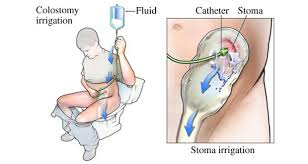It will be Pia’s first day to go on duty at the surgical ward as a student nurse tomorrow and tonight, she is determined to do everything that she can to be prepared. She knows that she will be able to encounter different cases in the surgical ward. With that in mind, she is both excited and nervous.
According to those who have experienced going on duty at the said ward, there are tons of procedures to learn about and one mentioned is colostomy irrigation. Both curious and wanting to learn, she opens her book and reads on everything she has to learn about the procedure.
Colostomy Irrigation
Colostomy irrigation is an effective method to achieve fecal continence in selected persons with a colostomy. In other words, it is a way to regulate bowel movements by emptying the colon at a scheduled time.
Done mainly to empty and cleanse the colon and rectum, to stimulate peristalsis and help develop regular bowel movement, and/or to relieve flatulence, this process involves infusing water into the colon through the stoma, thereby stimulating the colon to empty. This procedure is most effective when it is done about one hour after a meal, when the colon is most likely to be full.
By repeating this process regularly, which can either be once a day or once every second day, the colon can be trained to empty with no spillage of waste in between irrigation. It generally takes about six weeks to eight weeks for the bowel to become regulated with irrigation
However, it should be remembered that the danger of the perforation of the colon is much greater when irrigating a colostomy with a catheter as the use of an irrigation cone usually results in safer administration and better water flow.
Nursing Interventions
- Explain the procedure to the patient so as to gain the cooperation of the patient.
- Wash hands to avoid contamination.
- Bring equipment to the bedside and provide privacy to save time and promote the dignity of the patient.
- Assist the patient to turn on his left side or appropriate side in order to allow the nurse to do the procedure without difficulty.
- Place the emesis basin and newspaper at the foot of the bed to ensure that the waste are properly disposed.
- Expose the abdomen, drape the patient with a bath blanker if necessary since draping is also part in the provision of the patient’s privacy.
- Remove soiled dressings and place them on the emesis basin and newspaper at the foot of the bed so as to avoid contamination and control odor.
- Place the basin for return flow immediately under the colostomy opening. The patient can hold this in place if he is able. The basin must be ready to avoid spillage.
- Open the clamp on the tubing and allow a small amount of solution to flow into the basin. To release air bubbles in the set-up so that air is not introduced into the colon which would cause crampy pain.
- Lubricate the tip of the colon tube to facilitate the easy insertion of the tube.
- Insert the colon tube 6-8 inches into the colostomy opening to avoid irrigating the intestinal mucosa.
- Hold the enema can approximately 12 inches above the bed and allow the solution to flow in slowly. To avoid painful cramp usually caused by too rapid flow.
- When the basin is almost full, quickly remove it and place the second basin in position so as to avoid spillage.
- Empty the first basin immediately so that it will be ready for use if needed again.
- After the irrigation is finished, wash the area with soap and water and apply a clean dressing to the area since cleanliness and dryness will provide the patient with comfort.
- Return the equipment to the utility room, clean and return to the proper place as this will control odor and prolong life of the equipment.
Sources:
https://nurseslabs.com/colostomy-irrigation-nursing-procedure/
https://www.webmd.com/colorectal-cancer/colostomy-irrigation








